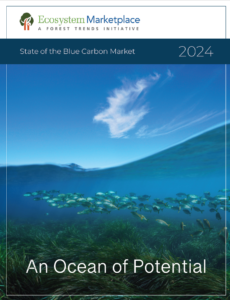State of the Blue Carbon Market
An Ocean of Potential
By Tundi Agardy View PublicationMany countries have already catalyzed major action toward carbon emissions reductions through reducing deforestation, forest degradation, conservation, sustainable management of forests and enhancement of forest carbon stocks (REDD+). The opportunities for ocean and coastal ecosystems to complement these mitigation efforts are many and are aided by the extensive experience gained through forest carbon initiatives. However, uptake of conservation and restoration projects in coastal and marine habitats that sequester carbon (collectively called blue carbon, or BC) has been slow and unsteady. Part of this has to do with inherent challenges of doing conservation and restoration in the ocean space. Another factor is the comparatively limited financing available to support BC project development, management, reporting, and verification.
Despite increasing interest in and attention to BC, a recognition exists that the full potential of coastal and marine habitats in mitigating climate change is far from being realized, and that more could be done to catalyze marine initiatives, both in terms of scaling up existing projects and expansion to new geographies. There are identifiable leverage points to bring BC to scale by assisting countries to incorporate BC habitats into their climate change mitigation strategies, as well as their planning for climate change adaptation and resilience. Likewise there are untapped opportunities to share lessons learned from project development for the carbon market.
Blue carbon remains in a dynamic state of play. Demand for carbon credits is growing in both compliance and voluntary markets, but in fits and starts. Many countries want to feature coastal management as part of integrated planning for sustainable development—both at the global level as guided by the Sustainable Development Goals (SDGs), and at the national level as coastal countries develop and expand their Blue Economies. The Kunming Montreal Global Biodiversity Framework and its 23 targets adds new emphasis on the need to conserve and restore BC ecosystems, not only for their mitigation potential but also because they support much of the world’s biodiversity, either directly or indirectly. The management of coastal ecosystems for climate mitigation appears in several countries’ climate change mitigation plans (known as Nationally-Determined Contributions, or NDCs), and may come to figure prominently in credit schemes under Article 6 of the Paris Agreement.
These and other drivers increase the demand for BC projects. Meanwhile the supply of those projects is aided by increasing availability of guidance for designing and executing projects that offer additionality and can therefore generate revenues through carbon credits.

